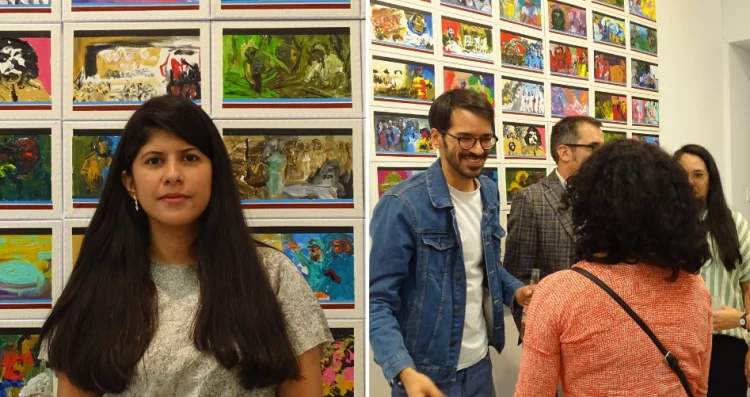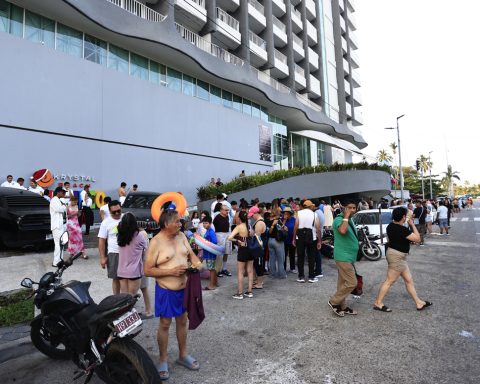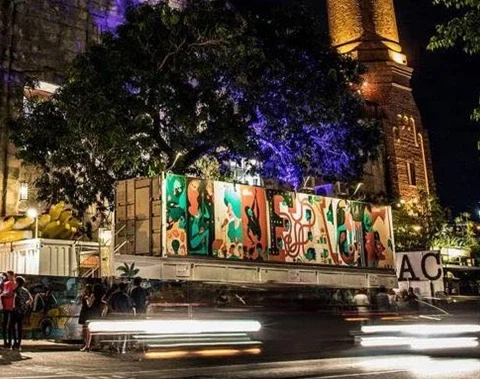MADRID, Spain.- The exhibition “Luminol” by Cuban artist Lorena Gutiérrez Camejo was inaugurated this Thursday, September 12, in the temporary space of Pan American Art Projects, located at Calle San Lorenzo 3, in the context of the Apertura Madrid Gallery Weekend. This event marks the beginning of the artistic season in Madrid, a platform that attracts both specialists from the art world and a general public interested in contemporary proposals.
A critical look at Cuba’s recent history
Curated by Aylet Ojeda, the exhibition “Luminol” uses abstract painting and installation to explore, from a critical perspective, some significant events in Cuba’s recent history. The title of the exhibition itself evokes a powerful metaphor: luminol is a chemical substance used at crime scenes to reveal traces invisible to the naked eye. Thus, Gutiérrez Camejo aims to “shed light on different events that occurred in Cuba and that are not well known,” as he explained during the opening in statements to CubaNet. As the artist points out, “we learn history in one way, but when you compare information, you can realize that it was not as it was told to you.” This desire to unmask hidden truths underlies each of the works on display.
Gutiérrez Camejo emphasizes her interest in political and social issues, especially those related to the exercise of power. “I have always been very interested in everything that is linked to the exercise of power. From the family environment, which is where one begins to notice these structures, to the historical environment, where the contrast of information is fundamental,” says the artist. Throughout the exhibition, this interest materializes through exhaustive research that questions official versions and reveals distorted truths.
On display
One of the most striking pieces in the exhibition is “Black Pentagram (Concert for Many Hands)”, a series of thirteen paintings dedicated to Cuban musicians censored by the regime, including Celia Cruz, Gloria EstefanWilly Chirino and Rita Montaner. The series is inspired by the covers of suspense books that circulated in Cuba during the Gray Five-Year PeriodWith an abstract and geometric aesthetic, Gutiérrez addresses the issue of censorship in the musical field, a problem that is still relevant today. According to the artist, this series reflects how music, like other areas of culture, has been subjected to censorship in Cuba.

Another outstanding work is Slavic aromas returna piece that revives the “Red Moscow” perfume, an icon of the Cold War and a symbol of the ideological bond between Cuba and the Soviet Union. Through this installation, the artist reflects on the resurgence of Russian political influence in Cuba in recent years. The use of perfume as a metaphor emphasizes the return of old ideologies and political alliances that continue to mark Cuban reality. This work invites the viewer to question how geopolitical power dynamics continue to influence contemporary Cuban society.

The piece “Leopoldo Ávila lives” revisits the figure of this cultural repressor, a non-existent character created by the Cuban regime to exercise censorship from the magazine Olive Green During the 1960s, Leopoldo Ávila was in charge of vetoing writers and artists who did not align themselves with the principles of the Revolution. About this work, Gutiérrez Camejo states: “Leopoldo Ávila was a pseudonym used to censor, and today we still have many ‘Leopoldos’. Artists are still subject to the same dynamics of control.” The work also evokes the phrase that the Cuban martyr Eduardo García Delgado wrote with his blood before dying: “Fidel.” This piece, with its historical and symbolic charge, invites us to reflect on the censorship strategies that still persist in Cuba.

Another work that stands out in the exhibition is The revolution, an abstract thing. In this piece, Gutiérrez uses commemorative stamps from the Cuban Revolution to construct a visual abstraction that questions the achievements celebrated by the regime. “These stamps were part of a special series that was printed in Cuba, showing the supposed achievements of the Revolution. But, when you see the reality, you realize that there are many distorted truths,” the artist explained. The work reflects the contrast between the official narrative and the lived reality.

An international context: Opening of the Madrid Gallery Weekend
The inclusion of “Luminol” in the Apertura Madrid Gallery Weekend underlines the importance of this exhibition not only for Gutiérrez Camejo’s career, but also for the visibility of contemporary Cuban art in the international arena. The artist herself commented on the relevance of this event: “The Apertura Madrid Gallery Weekend is an important event because it is the beginning of the art season in Madrid, and my gallery in the United States considered that it was the perfect time to show this project, which we have been preparing for more than six months.”

Curator Aylet Ojeda also highlighted the value of the exhibition in this context: “September is a very busy month in Madrid. Having Lorena’s exhibition here, in this space and at this event, is important for the visibility it gives her as an artist, both to her and to her work.” The event attracted a diverse and participatory audience that showed great interest in the works and their meaning. The arrangement of the pieces and the general atmosphere reflected the conceptual depth of the show and the impact that “Luminol” generates on the public.

“Luminol” is not just an art exhibition; it is a profound reflection on Cuba’s recent history and its political and social complexities. Through her works, Lorena Gutiérrez Camejo challenges official narratives, exposing hidden truths and creating a space for critical dialogue. The exhibition will be open until September 15, offering a unique opportunity to immerse oneself in contemporary Cuban art with a critical and committed eye.

















